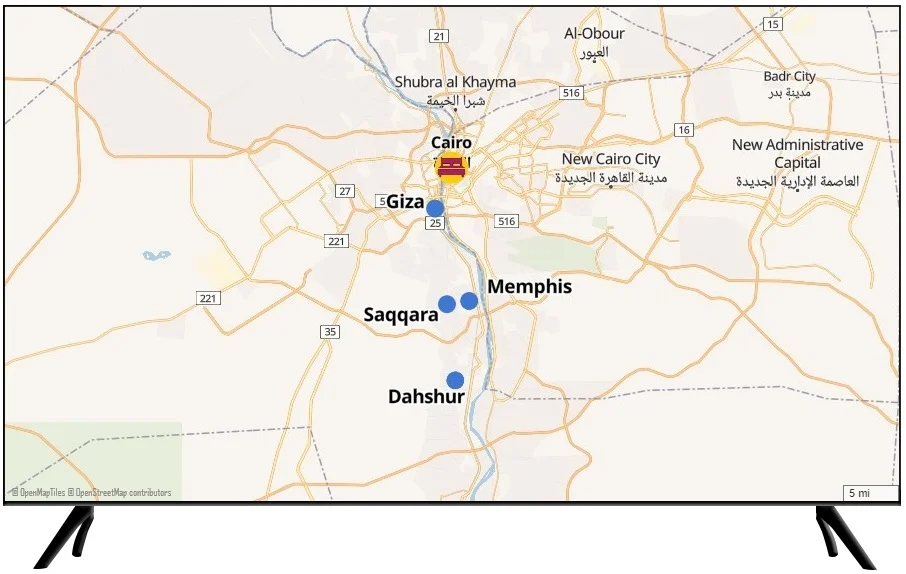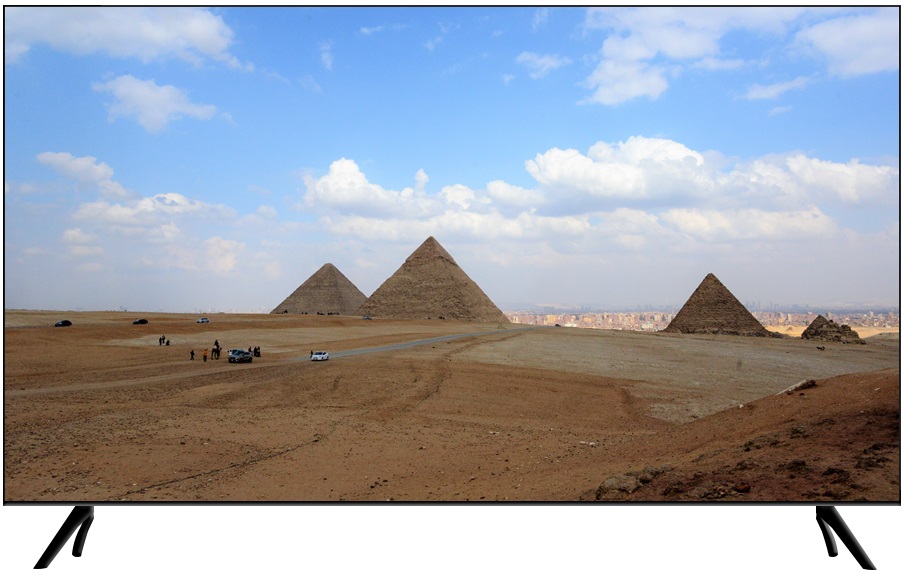


Day 2. Cairo
Overnight – Four Seasons Nile Plaza
Experience an exploration of The UNESCO World Heritage Sites at Giza, Memphis, Dahshur and Saqqara. All of them are located on the Memphite Necropolis, and your Egyptologist Tour Director will give you a fascinating introduction by showing you how the building of pyramids progressed over the centuries. The legendary city of Memphis, established in 3200 BC, is now a sleepy little rural/urban mix, and you will start by visiting the small Archaeological Park here. Among the statues and other objects in the open-air park is a massive statue of Ramses the Great, located in a building at the entrance of the park. This is one of the two colossal statues of Ramses the Great from ancient Memphis. The other statue has been fully restored and is now the centerpiece of the very impressive entrance hall of the still to open Grand Egyptian Museum. Unlike its museum counterpart, this massive statue is displayed prone on the ground and missing the lower part of its legs, but it is still awe-inspiring in its scale and detail. Among the other attractions in the small outdoor Archeological Park area is the Alabaster Sphinx of Memphis. This sphinx is actually made of Calcite, and at 26 feet by 13 feet the monument is much smaller than the Great Sphinx.
From here you will proceed nearby to Saqqara where you will see the oldest pyramid in Egypt, the 4700+ years old Djoser Step Pyramid. The massive ancient burial site of Saqqara also contains the oldest stone building complex in the world, as well as multiple ancient Mastaba tombs belonging to high-ranking citizens. Among these the Tomb of Udut, Unas-Ark and Inefert is well worth a walk through. Saqqara was used as a burial ground for 3000 years, lasting into the Roman period.
Another short drive will bring you to Dahshur, where you will experience how the Egyptians progressed on building pyramids after the Step Pyramid. Amazing attractions here include the 4600-year-old Bent Pyramid as well as the Red Pyramid, both built by the Pharoah Sneferu.
A 20-minute drive will take you to the Giza Necropolis, where you will break for an included lunch at a restaurant specializing in Egyptian delicacies. After lunch you will drive up the small plateau to the 3 amazing pyramids here, all of which are individually awe-inspiring. The Great Pyramid was built by Khufu, the son of Sneferu, the Pharoah who had the Bent Pyramid and Red Pyramid constructed at Dahshur. The Great Pyramid has always been the oldest member of the Seven Wonders of the Ancient World, and is now the only one of them still remaining. We will not attempt to describe the incredible size and splendor of these ancient structures – they have to be experienced to be believed.
After the Dahshur Pyramids the pharaohs got busy building these amazing structures and the two tallest pyramids, Khufu’s Great Pyramid and Khafre’s Pyramid, were finished within a few decades after the completion of the Red Pyramid at Dahshur. As Khafre was Khufu’s son, he built his pyramid to a height of 471 feet, as opposed to the Great Pyramid’s 481.4 feet height, but he built it on a slightly higher elevation close by, thereby making his pyramid seem taller. Although significantly smaller than these two pyramids, the third pyramid at Giza, built by Menkaure, son of Khafre, is well worth a visit.
Next up is the Great Sphinx, which is commonly believed to have been designed and constructed during the above-mentioned Khafre’s reign, with his face mounted on the mythical creature, although scholars are not certain and a debate on its exact origins is ongoing. It is 66 feet high and 62 feet wide and 240 feet long. The awe-inspiring structure offers great photo opportunities, including views with Khafre’s Pyramid as a magnificent backdrop.
Although there are remains of scores of other pyramids in Egypt, it is an interesting fact that the above mentioned largest still intact pyramids, with the exception of the Step Pyramid of Djoser at Saqqara, were all built over about just 80 years by four generations of Pharaohs, starting with Menkaure’s great grandfather, Pharoah Sneferu. You will avoid Cairo’s miserable rush hour traffic and return to your hotel after this exploration of Giza.
Experience an exploration of The UNESCO World Heritage Sites at Giza, Memphis, Dahshur and Saqqara. All of them are located on the Memphite Necropolis, and your Egyptologist Tour Director will give you a fascinating introduction by showing you how the building of pyramids progressed over the centuries. The legendary city of Memphis, established in 3200 BC, is now a sleepy little rural/urban mix, and you will start by visiting the small Archaeological Park here. Among the statues and other objects in the open-air park is a massive statue of Ramses the Great, located in a building at the entrance of the park. This is one of the two colossal statues of Ramses the Great from ancient Memphis. The other statue has been fully restored and is now the centerpiece of the very impressive entrance hall of the still to open Grand Egyptian Museum. Unlike its museum counterpart, this massive statue is displayed prone on the ground and missing the lower part of its legs, but it is still awe-inspiring in its scale and detail. Among the other attractions in the small outdoor Archeological Park area is the Alabaster Sphinx of Memphis. This sphinx is actually made of Calcite, and at 26 feet by 13 feet the monument is much smaller than the Great Sphinx.
From here you will proceed nearby to Saqqara where you will see the oldest pyramid in Egypt, the 4700+ years old Djoser Step Pyramid. The massive ancient burial site of Saqqara also contains the oldest stone building complex in the world, as well as multiple ancient Mastaba tombs belonging to high-ranking citizens. Among these the Tomb of Udut, Unas-Ark and Inefert is well worth a walk through. Saqqara was used as a burial ground for 3000 years, lasting into the Roman period.
Another short drive will bring you to Dahshur, where you will experience how the Egyptians progressed on building pyramids after the Step Pyramid. Amazing attractions here include the 4600-year-old Bent Pyramid as well as the Red Pyramid, both built by the Pharoah Sneferu.
A 20-minute drive will take you to the Giza Necropolis, where you will break for an included lunch at a restaurant specializing in Egyptian delicacies. After lunch you will drive up the small plateau to the 3 amazing pyramids here, all of which are individually awe-inspiring. The Great Pyramid was built by Khufu, the son of Sneferu, the Pharoah who had the Bent Pyramid and Red Pyramid constructed at Dahshur. The Great Pyramid has always been the oldest member of the Seven Wonders of the Ancient World, and is now the only one of them still remaining. We will not attempt to describe the incredible size and splendor of these ancient structures – they have to be experienced to be believed.
After the Dahshur Pyramids the pharaohs got busy building these amazing structures and the two tallest pyramids, Khufu’s Great Pyramid and Khafre’s Pyramid, were finished within a few decades after the completion of the Red Pyramid at Dahshur. As Khafre was Khufu’s son, he built his pyramid to a height of 471 feet, as opposed to the Great Pyramid’s 481.4 feet height, but he built it on a slightly higher elevation close by, thereby making his pyramid seem taller. Although significantly smaller than these two pyramids, the third pyramid at Giza, built by Menkaure, son of Khafre, is well worth a visit.
Next up is the Great Sphinx, which is commonly believed to have been designed and constructed during the above-mentioned Khafre’s reign, with his face mounted on the mythical creature, although scholars are not certain and a debate on its exact origins is ongoing. It is 66 feet high and 62 feet wide and 240 feet long. The awe-inspiring structure offers great photo opportunities, including views with Khafre’s Pyramid as a magnificent backdrop.
Although there are remains of scores of other pyramids in Egypt, it is an interesting fact that the above mentioned largest still intact pyramids, with the exception of the Step Pyramid of Djoser at Saqqara, were all built over about just 80 years by four generations of Pharaohs, starting with Menkaure’s great grandfather, Pharoah Sneferu. You will avoid Cairo’s miserable rush hour traffic and return to your hotel after this exploration of Giza.

